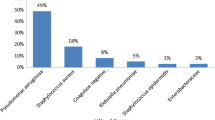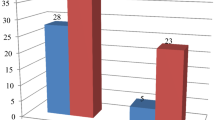Abstract
Chronic suppurative otitis media (CSOM) is one of the most commonly encountered diseases in otolaryngology practice. Even in this era of powerful antibiotics, CSOM still consumes considerable medical expenditure, especially in the poorer sections of the society. The present prospective study was conducted at the IGM Hospital, Agartala, in North East India towards clinico-microbiologic evaluation of chronic suppurative otitis media. The focus was mainly on aerobic bacteria, involved in active CSOM in adults as well as children. An attempt was made, despite resource and man power constraints, to have a glimpse of the current antibiotic sensitivity pattern, with special reference to ciprofloxacin. However, the main aim of this study is to see the types of aerobic bacteria involved in CSOM, in our region. Aural swabs were collected from 100 ears, from 97 patients complaining of ear discharge, continuous or intermittent, with a non- intact tympanic membrane for at least 12 weeks. Swabs were sent to the hospitals microbiology laboratory for culture and sensitivity tests. Bacteria could be isolated in 53 cases and 47 swabs were culture negative. The commonest bacteria isolated was pseudomonas (20) followed by Staphylococcus aureus (11), E. coli (11), proteus (9) and klebseilla (2). Three patients had bilateral ear discharge of which one had proteus in both ear swabs, one grew proteus in one ear and no growth in the other, and one patient showed no aerobic bacteria in any of his ear swabs. Among the culture positive cases (n = 53) gram negative bacteria were isolated in 79.24% (n = 42) and S. aureus in 11(20.75%) cases. Among 97 patients number of male and female patients was 50 and 47, respectively. Pseudomonas, E. coli, Bacilli proteus and S. aureus were the predominant bacteria involved in CSOM. Out of the 53 positive isolates ciprofloxacin could be tested against 35 i.e., 66%. Ciprofloxacin was sensitive in 26 isolates, intermediately sensitive in 4 and resistant in only five isolates. It is concluded that, gram negative bacteria especially pseudomonas is the commonest bacteria involved in CSOM in this part of north east India. Ciprofloxacin is an important tool in the management of active CSOM as it is cheap, less ototoxic and widely available as topical preparations.


Similar content being viewed by others
References
Roger FG (1997) Acute and chronic suppurative otitis media. In: David AA, Michael JC, Alan GK (eds) Scott-Brown’s otolaryngology, vol 6, 6th edn. Butterworth Heinemann, London, pp 1–25
WHO/CIBA Foundation Workshop (1996) Prevention of hearing impairment from chronic otitis media. WHO/PDH/98.4. CIBA Foundation, London
Bluestone CD, Gates GA, Klein JO, Lim DJ, Mogi G, Ogpra PL et al (2002) Definitions, terminology and classification of otitis media. Ann Otol Rhinol Laryngol 111:8–18
Saini S, Gupta N, Aparna, Seema, Sachdeva OP (2005) Bacteriological study of paediatric and adult chronic suppurative otitis media. Indian J Pathol Microbiol 48(3):413–416
Pajor A, Durko M, Jankowski A, Bartoszko-Tyczkowska A, Stanczyk R (2006) Bacteriological evaluation in chronic otitis media. Otolaryngol Poland 60(5):757–763
Yang Y, Gong S, Liu Y (2001) The clinical investigation of bacteriology of chronic suppurative otitis media. Lin Chuang Er Bi Yan Hou Ke Za Zhi 15(12):550–552
Wintermeyer SM, Nahata MC (1994) Chronic suppurative otitis media. Ann Pharmacother 28:1089–1099
Bowell JB, Nienhuis TG (1996) Patterns of persistent otitis media in the first year of life in Aboriginal and non-Aboriginal Australian. Ann Otol Rhinol Laryngol 105:893–900
Couzos S, Lea T, Mueller R, Murray R, Culbong M (2003) Effectiveness of ototopical antibiotics for chronic otitis media in Aboriginal children: a community-based, multicentre, double-blind randomised controlled trial. Med J Australia 179:185–190
Jang CH, Park SY (2004) Emergence of ciprofloxacin-resistant pseudomonas in chronic suppurative otitis media. Clin Otolaryngol Allied Sci 29(4):321–323
Derlacki EL (1951) Aural manifestations of allergy. Ann Otol Rhinol Laryngol 61:179
Albert RR, Job A, Kuruvilla G, Joseph R, Brahmadathan KN, John A (2005) Outcome of bacterial culture from mastoid granulations: is it relevant in chronic ear disease. J Laryngol Otol 119(10):774–778
Author information
Authors and Affiliations
Corresponding author
Rights and permissions
About this article
Cite this article
Deb, T., Ray, D. A Study of the Bacteriological Profile of Chronic Suppurative Otitis Media in Agartala. Indian J Otolaryngol Head Neck Surg 64, 326–329 (2012). https://doi.org/10.1007/s12070-011-0323-6
Received:
Accepted:
Published:
Issue Date:
DOI: https://doi.org/10.1007/s12070-011-0323-6




